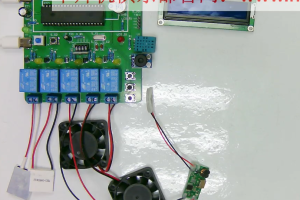设计说明书
总字数:18000+
随着人们生活水平的提高,人们对婴儿的照顾更加周到,但是婴儿无行为能力,抵抗力弱,一旦遇见突发情况,极易发生危险,这就要求家庭需对婴儿进行安全监护,有效降低其遇到危险的可能,从而提高婴儿的安全性。随着相关等相关技术的发展,婴儿监护系统的发展进行关键时期。本设计采用STC89C52单片机作为主控芯片,开发一款智能婴儿箱,采用三个不同的传感器分别监测儿箱内温湿度、CO2浓度以及婴儿体温,通过按键进行界面切换和阈值设置,并通过LCD1602对温湿度、CO2浓度、体温等测量数据进行实时显示,方便监护人实时查看婴儿箱环境参数,进而通过相关外围设备调节婴儿箱的环境参数,保证婴儿箱内的环境参数处于最佳状态,为婴儿提高优良的生活环境。实物测试表明,该婴儿监测系统基本实现了预设功能,为婴幼儿的成长提供优良的环境。
关键词: 婴儿箱;传感器;单片机;按键;显示屏
Abstract
With the improvement of people’s living standards, people’s care for infants is more thoughtful, but infants have no behavioral ability and weak resistance, once they encounter unexpected situations, they are prone to danger, which requires families to carry out safety monitoring of infants, effectively reduce the possibility of their exposure to danger, thereby improving the safety of infants. With the development of related technologies, the development of infant monitoring systems has undergone a critical period.In this design, STC89C52 single chip microcomputer is used as the main control chip to develop a smart baby box. Three different sensors are used to monitor the temperature and humidity in the baby box, the concentration of CO2 and the temperature of the baby, and the interface switch and threshold setting are carried out by pressing buttons, and the measurement data of temperature and humidity, CO2 concentration and temperature are displayed in real time through LCD1602. It is convenient for the guardian to view the environmental parameters of the baby box in real time, and then adjust the environmental parameters of the baby box through relevant peripheral devices to ensure that the environmental parameters of the baby box are in the best state, and improve the good living environment for the baby.The actual test shows that the infant monitoring system basically realizes the preset function and provides a good environment for the growth of infants.
Keywords:baby box; Sensor; Single-chip computer; Key; Display screen
目 录
摘 要
Abstract
第一章 设计概述
1.1 研究背景及其意义
1.2 国内外研究现状
1.3 此次设计实现的功能
第二章 系统设计方案
2.1 系统设计方案
2.2 主要元器件选择
2.2.1 主控芯片方案
2.2.2 显示模块方案选择
2.2.3 按键模块方案选择
2.2.4温湿度检测模块方案选择
第三章 硬件设计
3.1 单片机最小系统
3.1.1主控模块电路
3.1.2 晶振电路
3.1.3 复位电路
3.1.4 电源电路
3.1.5下载电路
3.2 DHT11温湿度检测模块电路
3.3MLX90614测温模块电路
3.4CO2检测模块电路
3.5按键电路模块
3.6 LCD1602显示模块电路
3.7声光报警报警提醒电路模块
3.8 继电器控制模块
第四章 系统程序设计
4.1 编程软件介绍
4.2 系统主流程设计
4.3独立按键
4.4 温湿度检测模块子流程
4.5 LCD1602液晶显示子流程
5 系统仿真测试
5.1 仿真总体设计
5.2 CO2浓度调节仿真测试
5.3温湿度模块仿真测试
5.4 体温调节仿真测试
第六章 实物测试
6.1实物焊接
6.2 CO2浓度调节实物测试
6.3温湿度模块实物测试
6.4 体温调节实物测试
总结
致谢
参考文献
附录
附录一:原理图
附录二:PCB
附录三:主程序
购买后可查看具体内容!

